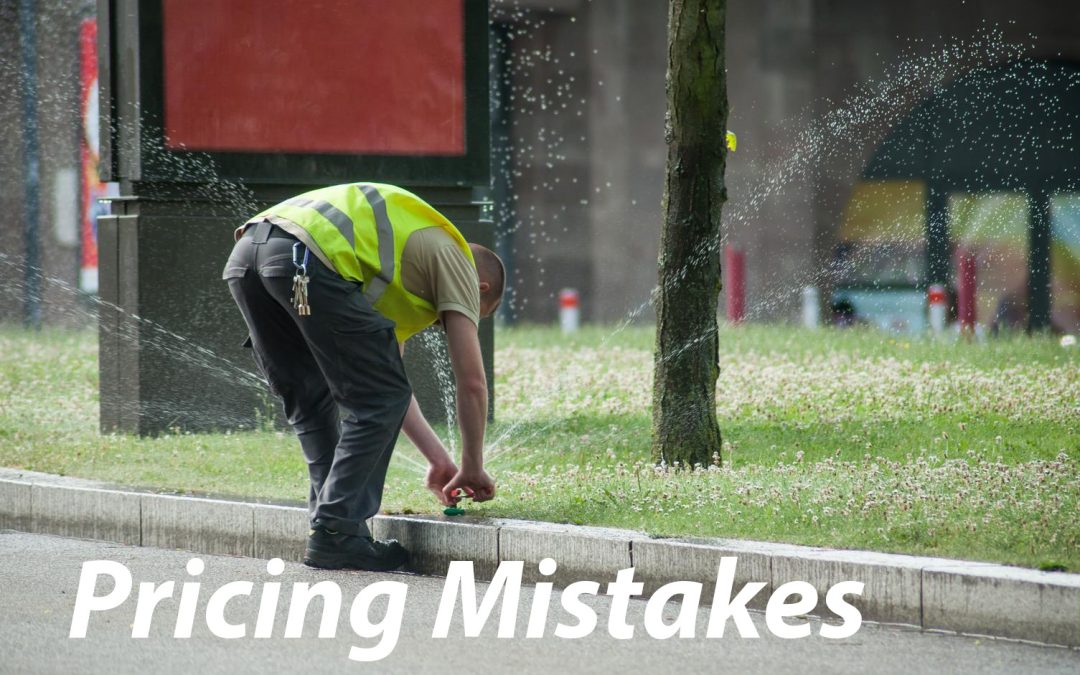Dear Lawn or Landscape Business Owner: The fastest way to destroy a perfectly good landscape business is failure to Price Right!
Listen it’s not just about making the sale—it’s about making a desired profit. Too many landscapers fall into common pricing traps that lead to undercharging, overworking, and, ultimately, financial pain.
Over the last three and half decades I’ve met some of the hardest-working, salt-of-the-earth-people in our land – lawn and landscape business owners. Unfortunately, hard work alone rarely creates a wealthy landscaper. You gotta Price Right!
You ARE Pricing Right when the work is profitable for YOUR company AND the CUSTOMER HIRES YOU! As we get ready to welcome in 2025 (and the College Football Playoffs)…
Let’s dive into the six biggest pricing mistakes landscapers make and how to fix each one, using our 6-Point Pricing Formula.
1. Ignoring the Real Cost of Labor
The Mistake: Many landscapers calculate wages (and they go up every single year) but forget to include payroll taxes, workers’ compensation, new government mandated benefits like the FMLA, company supplied benefits, and downtime. Yep. Every dollar of wages is subject to an additional fee. We call it “Labor Burden”. And if you fail to calculate it correctly and include it in your pricing formula, when the bills come callin’ they will be sucking away profits. Ouch!
The Fix: Your employees are expecting a pay raise. You better plan for it right now! And…every job you price for 2025 better have the NEW pay rate figured in…or you’ll suffer. Then there’s another problem you must solve. This has to do with your company’s efficiency. If your crew is paid for 40 hours but only bills for 30, you’ve got to account for that gap. Bad weather, terrible traffic, gossip-hungry customers, and employees stuck on the cell phone working out a girlfriend problem destroys productivity. Your pricing system MUST account for your inefficiency!
2. Guessing at Material Costs
The Mistake: Underestimating material costs—or worse, not including delivery fees, green goods warranty or waste factors like that busted bag of fertilzer—means you’re eating into your profit before you even start the job.
The Fix: Get quotes directly from suppliers and include everything: shipping, storage, and a percentage for waste. A good rule of thumb? Add 10-15% to your material costs for those “oops” moments when a paver cracks or a tree dies or gets damaged by your guy on the skid loader.
At the same time, don’t try to mark up materials by a 200% or 300% X factor. There’s very little risk in buying and selling materials. There’s huge risk in hiring and managing employees.
3. Forgetting (or Underestimating) Equipment Costs
The Mistake: You charge for labor and materials but overlook the cost of running your equipment. Mowers, trucks, and trimmers aren’t free, folks—they’re ticking time bombs of depreciation and maintenance. We love equipment! It boosts productivity to incredible levels when used properly. But careless operators shorten its lifespan.
The Fix: Calculate your equipment costs per hour of use. Include acquisition costs, interest, fuel, repairs, insurance, maintenance and replacement costs with an inflation factor built in. Total these costs and you will be surprised what something as small as a back-pack blower costs each year. Look at these calculations below for an example.
Example 1: A 800 CFM gas-powered back pack blower used to clean debris in the landscape will burn approximately ¾ gallon of gasoline per hour of operation. Just one back pack blower on a lawn service crew can easily operate 500 hours per year.
Here’s the math. 500 hours x .75 gal/hr = 375 gallons per year… and… 375 gallons of gas at $6/gallon (high octane fuel plus oil mix) is a wallet busting $2,250 per year in fuel cost. So $2,250 / 500 hours = $4.50/hr just for fuel costs!
Acquisition costs of $800 / 500 hours = $1.60/hr (if your blower last two years change to $.80/hr)
Repair costs of $200 / 500 hours = $.40/hr (if you keep it two years you better increase this)
Total hourly costs = $4.50 fuel costs + $1.60 acquisition costs + $.40 repairs = $6.50/hr
So what do you think it costs to operate the truck you drive?
How about that zero turn lawn mower or skid loader?
It’s a LOT MORE than $6.50 hour.
Equipment should be handled as a pass-through expense in your pricing system. Equipment should NEVER cost you one thin dime if you build that cost into your pricing system.
4. Ignoring Overhead
The Mistake: Overhead costs—like rent, utilities, insurance, and admin salaries—don’t show up on a job site, so they’re easy to forget. But ignoring them will leave you in the red faster than crabgrass popping up in the summer.
The Fix: Total your annual overhead expenses and make sure you include the FUTURE payment of that commercial facility you have thinking about buying (or expanding). Don’t be shy—your office, facility, lights and website aren’t free!
Every single hour of labor you sell must be marked up to recover your overhead costs. Most contractors underestimate their overhead costs. If you need help figuring your overhead costs, watch this video.
5. Skimping on Profit
The Mistake: Too many landscapers treat profit like an afterthought. They focus on covering costs and hope there’s money left over. Hope isn’t a profit strategy. Our industry has long suffered from puny little profits (as reported via the IRS) and industry cost operating studies.
The Fix: Decide on your profit margin upfront. A good starting point is 10-20%. For every job, add this percentage ON TOP OF your total costs. Profit isn’t just a reward—it’s what keeps your business growing and your family fed.
6. Failing to Plan for Risk
The Mistake: Unexpected weather, accidents, errors in estimating, errors in measurements or plan take offs, equipment breakdowns, or unscrupulous buyers can turn a profitable job into a money pit. Most landscapers don’t account for these risks in their pricing.
The Fix: Buy insurance! Never operate your business without commercial insurance! Review your commercial insurance policy each year. Then get two or three bids to make sure you have yourself covered at a reasonable cost.
We know that most contractors underprice work with the hope to win the bid. So try this strategy.
Add a contingency buffer of 5% to every job you price this month. This safety net ensures that surprises don’t eat into your profit.
If your schedule is full after 30 days, add another 5% for the next 30 days. See what happens. I’ll bet you still have plenty of work.
And if you don’t use it and everything goes perfectly? That 5% extra goes straight to your bottom line. You can write me a nice email and thank me for this advice one day in the near future…because you’ll be on the road to becoming The Wealthy Landscaper in your home town!
Putting It All Together
To avoid these mistakes, follow this simple formula:
Labor + Materials + Equipment + Overhead + Profit + Risk = Your Price
The key is tracking and forecasting your actual numbers—not relying on what the guy down the street charges. By accounting for all six components, you’ll price jobs confidently and profitably.
Final Word: Be the Pro, Not the Low-Baller
Remember, your pricing reflects your professionalism. Landscapers who underprice don’t stay in business long. Clients may balk at higher prices, but the right ones will pay for quality and reliability. Take the time to explain your company history, your vision for the future, why you choose to be a professional landscaper and never apologize for running a profitable business.
And when you meet a competitor who IS a lowballer – send them to this page where they can learn how to Avoid the Temptation To Think Like A Lowball Landscaper – seriously.
Run the numbers, fix the mistakes, and start pricing like a pro. You’re not just mowing lawns—you’re building a business!
Here’s to your success in 2025!
Tony Bass, founder
866-923-0027
PS – Join us at the next Profit Builder Training Event.

